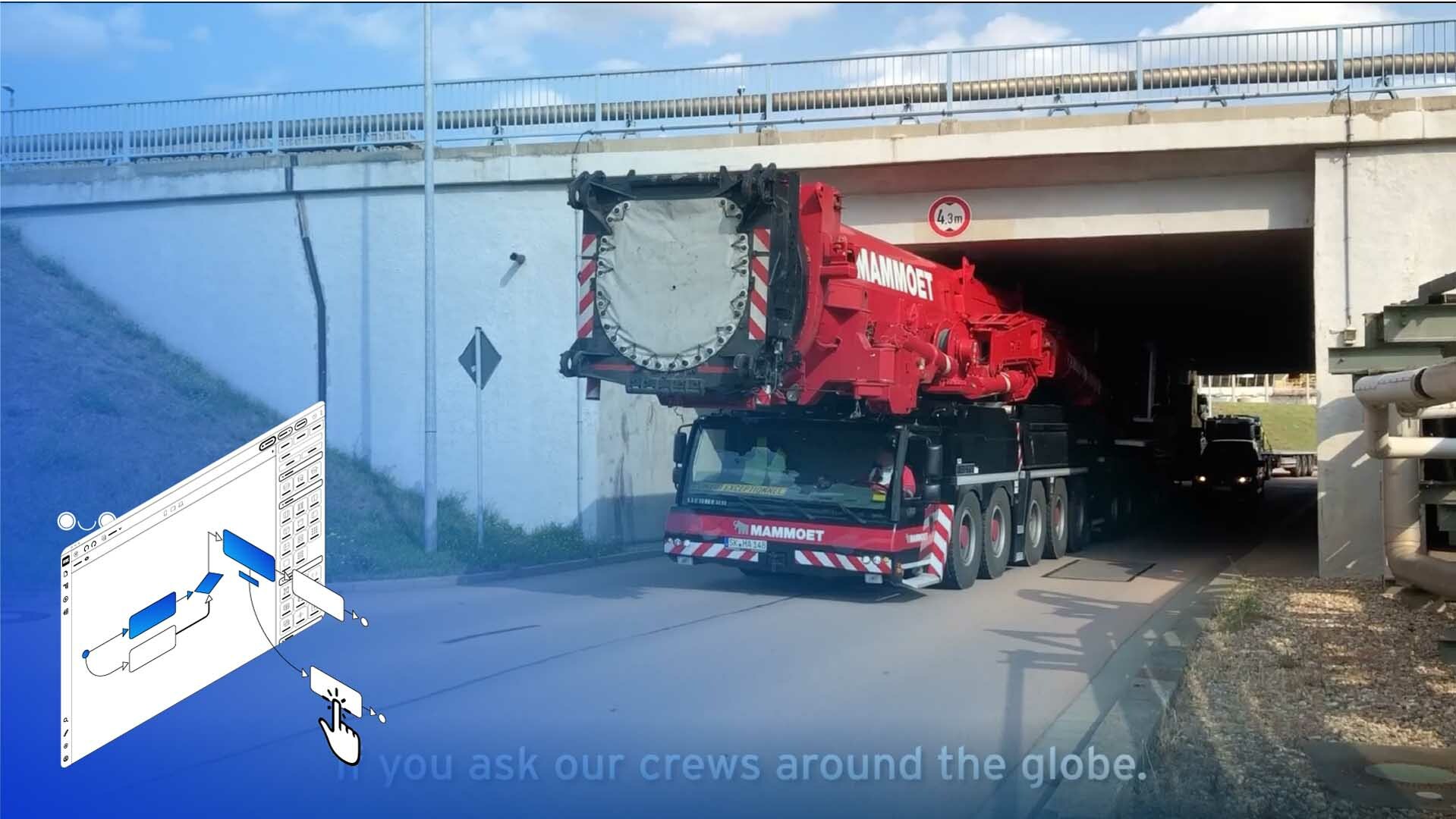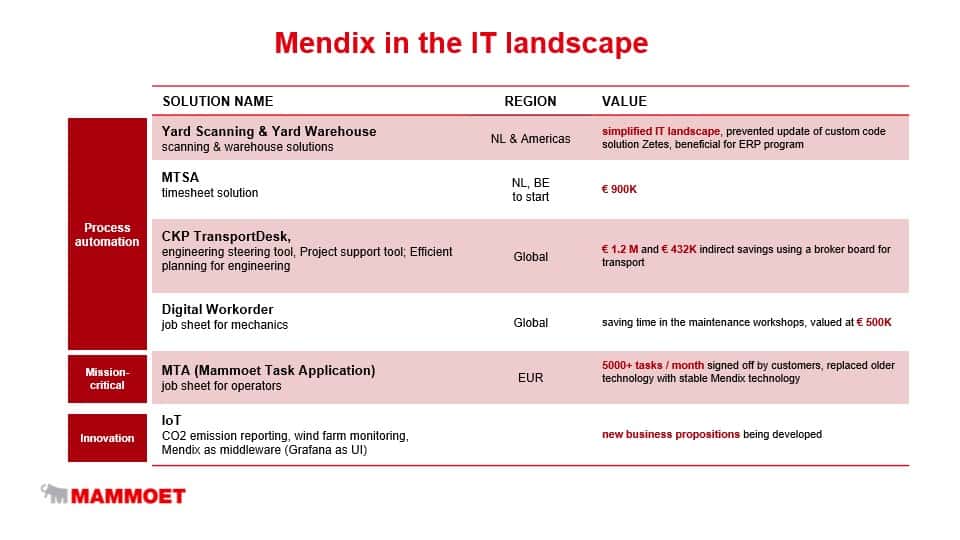Enabling Ongoing Digital Experience Innovation with Mammoet

Mammoet is a global market leader in heavy lifting and transport, specializing in oil & gas, petrochemical, power generation, civil and offshore transport. Their company mantra of “no job too small” displays their commitment to servicing companies of all sizes all over the globe.
In its 200 years of history, Mammoet has moved from a small family business to a global enterprise operation with 6,200 employees operating out of 45 countries and over €1 billion annual revenue.
At Mendix World 2021, Gerrit Dekker, Chief Information Officer, and John Helmink, Business Applications & Digital Innovation, from Mammoet joined Hans De Visser, VP Product Management from Mendix, to discuss how low-code has helped Mammoet to continue to innovate and delight their end-users.
Global Solutions for the Future
Mammoet’s ICT organization supports every employee on every job, whether it’s a single crane lifting a roof off a building or a multi-year project like building a gas plant.
In thinking about their digital development, key for Mammoet is optimizing their employee user experience. The team faced several challenges.
- Global team: Mammoet has the advantage of one way of working across the globe but face the issue of different regions having different requirements. “It’s always a matter of staying in close contact with those doing the actual job, and still being able to provide one way of working,” Helmink said. Creating new solutions that would work for their employees in all locations around the globe was key.
- Efficiency/Centralization: “We wanted to stay away from individuals doing development,” Helmink described. He continued that specifically, there would be “the challenge of maintaining it and not being dependent.” Any future solutions would have to be centrally managed and resourced.
- ERP/Generational needs: Mammoet is working with an older version of SAP. The long-term plan is replacement, but, in the meantime, Dekker noted that “we have a modern generation who is used to apps, mobile phones, tablets, smartphones.”
- Innovation: Mammoet was keenly interested in planning for emerging technology, and, particularly, how they could implement IoT sensors and data into their workflow. Better insights into issues like emissions would help reduce costs and drive future digital innovation.
A Focus on the Front-end
Low-code proved to be particularly attractive to Mammoet for many reasons. First among these is that the Mendix low-code development platform can use SAP integrations to create modern, front-end applications without having to heavily customize its ERP.
Low-code helped Mammoet develop “more and more apps into the various work areas and the various countries,” according to Dekker. The end goal is for most users to see a Mendix application rather than an ERP screen.
One particular use case for this involves Mammoet’s crane operators. Previously, with only SAP interfaces as an option, crane operators were getting much more information than needed. This led to delays and confusion.
A new Mendix front end, called Mammoet Task Application, surfaces just “the most essential information to the operator [to] let him work with it,” Helmink described. “And when he or she finishes his or her job, just put a signature there and get it back into that ancient ERP system.”
This is a mission-critical project for Mammoet, with as many as 600 daily users and more than 5,000 monthly tasks. Being an offline-first portal, a reliable experience regardless of connection strength was key.
Helmink said, “We are really happy with the fact that it’s very reliable.”
Central Development, Global Outcomes
The Mendix platform also enabled Mammoet to conduct their application development as a central operation, rather than as regionally-managed bespoke projects. “We are lean and mean as an IT department in Mammoet,” said Dekker.
Further, low-code development coupled with this centralized approach could help solve the issue of localization. “Mendix also allows for a rapid adoption to small local customizations,” Dekker highlighted.
In this way, Mammoet could continue to think of its processes globally, offering the flexibility for localization only when necessary.
Enabling Future Digital Innovation with IoT
The Mendix platform integrates neatly with IoT data, allowing Mammoet to think aggressively about what data they want to collect and what they want to do with it.
The team is working through several IoT- and Mendix-based proofs of concept. One of these concepts is to allow employees in the field to see wind speeds, which has a big impact on heavy lifting. The team at Mammoet is also exploring items such as CO2 emissions. This work will help Mammoet to work more efficiently and greener and can guide future decisions on the impact of their operations.
“It’s not just cost savings…with a reduction of operational cost and also productivity,” De Visser noted.
Engagement Leads to an Improved User Experience
Mammoet continues to integrate Mendix into their global IT landscape.
A new timesheet solution piloted in the Netherlands and Belgium has already created a €900k savings. Another example is Mammoet’s new TransportDesk application. When factoring in savings using a broker board, TransportDesk has created over €1.6m in savings.
Finally, a digital workorder app for Mammoet mechanics has resulted in time savings valued at €500k for the company.
Mammoet is continuing to explore new applications and ways to maximize the business value that Mendix is able to provide.

While reflecting on their experience using low code, Dekker suggested, “I think you just have to start doing it…Just make some low-hanging-fruit cases that you can demonstrate quite quickly to your boards.”
Helmink added that the key to Mammoet’s success has been user engagement. “It’s very important to show what you’re capable of, what the limitations are also,” he said. “You have to engage them in what you need to do. And what is the expectation that you have? You must have a common ground there.”
For Mammoet, one of the biggest successes has been in improving its end-user experience and global employee satisfaction. “Maybe something that doesn’t speak from the numbers is the fact that you can actually make people happy,” said Helmink.
He concluded, “That’s, in the end, why you’re in there.”